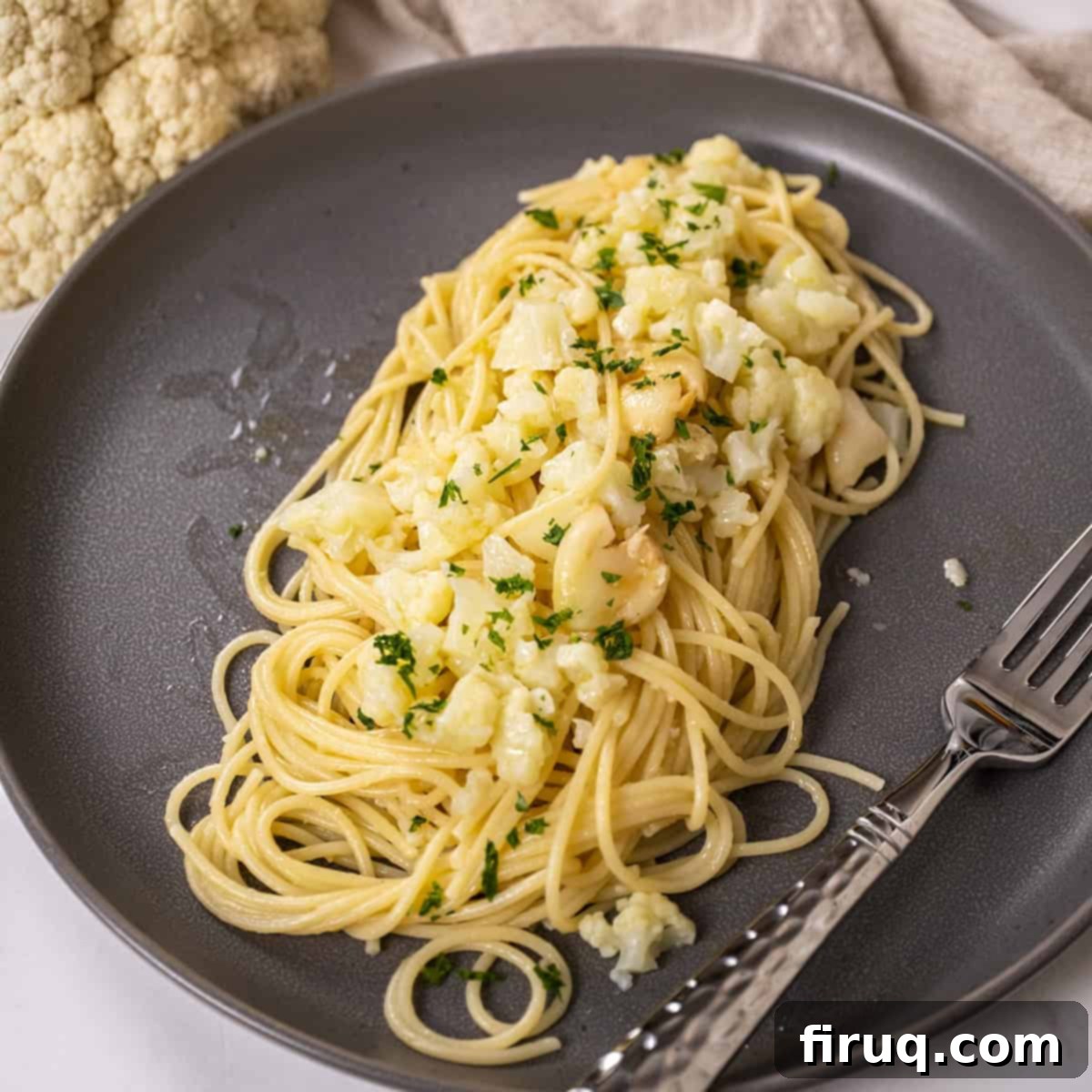Effortless & Flavorful Garlic Cauliflower Pasta: Your Go-To 30-Minute Weeknight Meal
Discover the magic of a speedy and incredibly convenient pasta with cauliflower recipe that graces your table in under 30 minutes. This garlic-infused, wholesome dish is a true game-changer for those busy weeknights when you need a meal that’s both quick to prepare and absolutely delicious. Far from sacrificing flavor for speed, this recipe perfectly balances simplicity with rich, comforting tastes, making it an instant family favorite.
If you’re constantly on the hunt for more easy vegetable pasta dishes to add to your weeknight rotation, you’re in good company! Beyond this fantastic cauliflower pasta, we highly recommend exploring other delightful options like our classic Pasta alla Norma (A Sicilian Dish) or the wonderfully creamy Creamy Red Pepper Sauce, both designed to bring joy to your dinner table without the fuss.
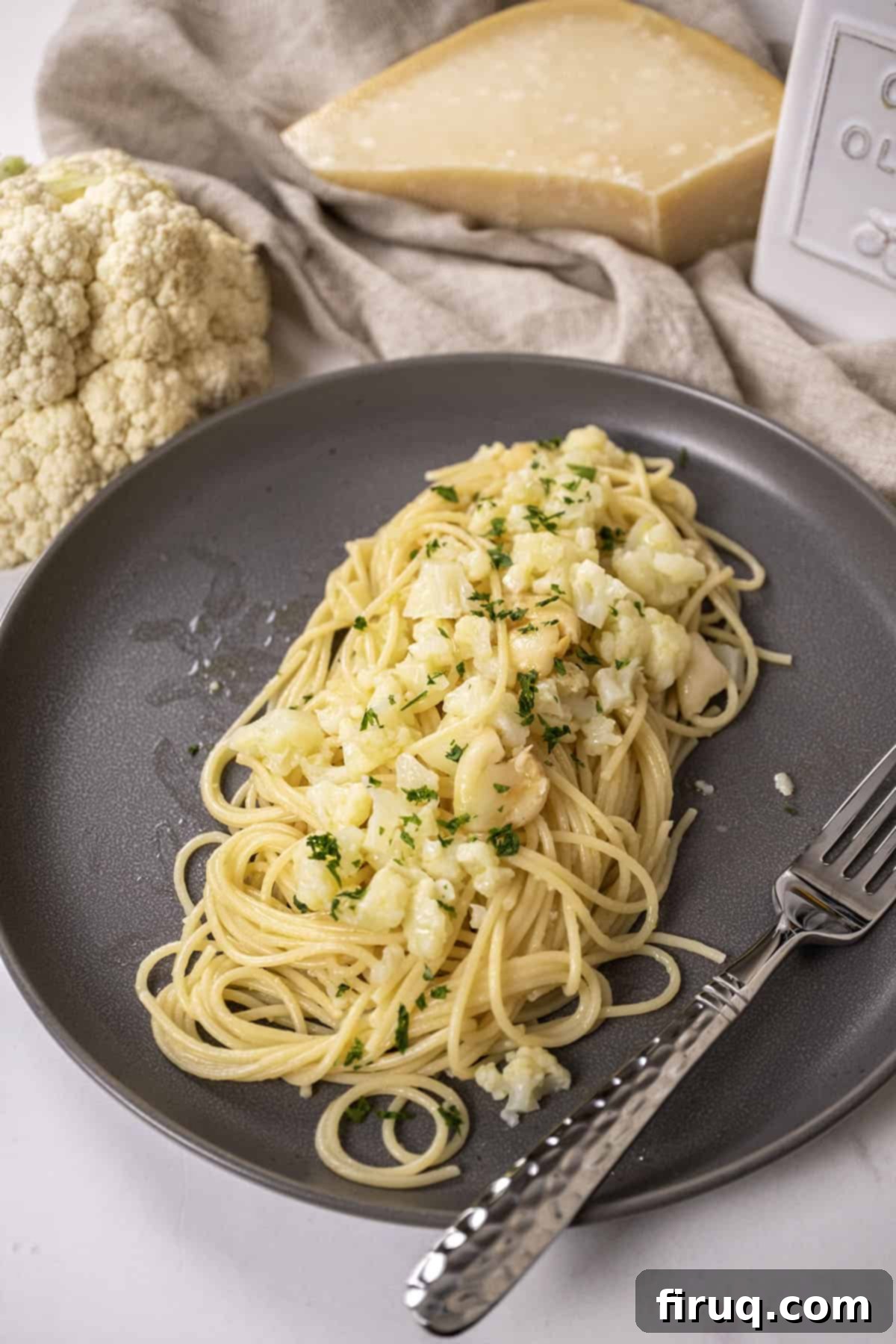
Still craving more simple pasta recipes that prioritize flavor and speed? Be sure to give our 15-Minute Spaghetti with Garlic and Oil and Simple Pasta with Eggplant and Tomatoes a try. Each one is a testament to the fact that incredibly satisfying meals don’t have to be complicated or time-consuming.
[feast_advanced_jump_to]
The Art of Simple Weeknight Meals: Why This Cauliflower Pasta Shines
Life moves fast, and sometimes, crafting a quick and easy meal that also packs a nutritional punch feels like an impossible feat. That’s precisely where our garlic cauliflower pasta comes into its own. This recipe masterfully combines speed and nutrition, ensuring you don’t have to compromise on either. When I prepare meals for my family, my primary goal isn’t to meticulously track every single nutrient, but rather to guarantee that we’re consistently incorporating a healthy vegetable into our diet. This dish makes that goal delightfully achievable.
Every household benefits from having a repertoire of reliable, go-to convenient meals. These are the dishes you can whip up without much thought, even after the longest day at work, and still feel confident that your family will eagerly enjoy them. Whether it’s this incredibly comforting pasta with cauliflower, a vibrant Artichoke Pesto Pasta, or a rich and satisfying Creamy Lemon Chicken, having these recipes on hand is a lifesaver. Our cauliflower pasta perfectly fits this category, offering a wholesome and delicious solution that caters to both your busy schedule and your family’s taste buds.
The Health Benefits of Cauliflower in Your Pasta
Beyond its versatility and mild flavor, cauliflower is a nutritional powerhouse. It’s an excellent source of Vitamin C, Vitamin K, and B vitamins, including folate. It also provides a good amount of fiber, which is essential for digestive health. By incorporating cauliflower into your pasta, you’re not just adding a vegetable; you’re boosting the overall nutritional value of your meal, making it a smart choice for health-conscious eaters. Its low-calorie and low-carb nature also make it a fantastic alternative or complement to heavier pasta dishes.
Essential Ingredients & Creative Substitutions for Cauliflower Pasta
Crafting the perfect pasta dish often comes down to understanding your ingredients and knowing how to make them shine. For this simple yet profound cauliflower pasta, each component plays a crucial role in building layers of flavor. Here’s a closer look at the key players and how you can adapt them to your pantry and preferences.
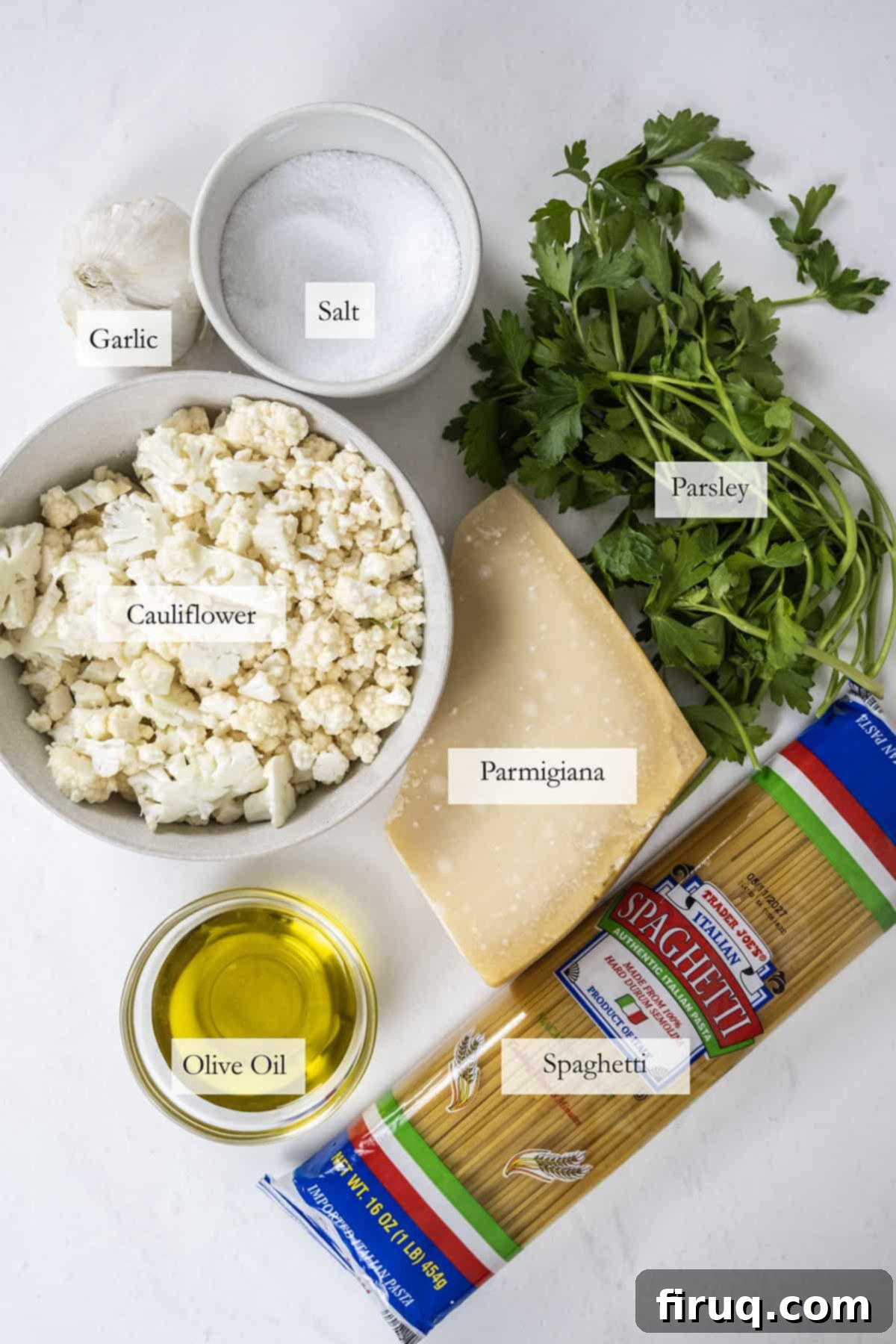
Cauliflower: The Star of the Show. Fresh, firm cauliflower florets are ideal for this recipe. When cooked correctly, they soften beautifully and crumble into the sauce, creating a delightful texture that melds seamlessly with the pasta. The mild, slightly nutty flavor of cauliflower provides an excellent base for the robust garlic and olive oil. However, this recipe is incredibly forgiving, allowing for various substitutions:
- Broccoli: For a similar texture and nutritional profile, simply substitute broccoli florets. The preparation method remains largely the same.
- Zucchini or Squash: If you prefer a different vegetable, finely diced zucchini or yellow squash can be fantastic. Instead of boiling, you would simply sauté them directly in the pan with the garlic until tender and lightly browned.
- Asparagus or Green Beans: Cut into bite-sized pieces, these vegetables can also be added. Blanch them briefly before adding to the pan for the best results.
Olive Oil: The Flavor Foundation. A high-quality extra virgin olive oil is not just a cooking fat here; it’s a foundational flavor element. It carries the garlic’s aroma and helps emulsify the sauce. Depending on the size of your cauliflower head and how much “sauce” you desire, you might need slightly more than the initial ¼ cup. Remember, the goal is to coat the ingredients beautifully without making it greasy. A crucial tip: when you transfer the cooked pasta, always add a little bit of the starchy pasta water. This magical liquid helps emulsify the olive oil and creates a slightly creamy, cohesive sauce that clings perfectly to every strand of spaghetti.
Garlic: The Aromatic Heart. This recipe truly highlights the incredible power of garlic. Using a whole head of crushed garlic might seem like a lot, but it mellows beautifully when sautéed in olive oil, infusing the entire dish with its warm, savory fragrance. Don’t be shy with it! For best flavor, use fresh garlic and crush it just before adding it to the pan.
Spaghetti: The Perfect Canvas. While spaghetti is traditional and works wonderfully, feel free to use your favorite long pasta shape like linguine or fettuccine, or even a shorter pasta like penne or orecchiette. The key is to cook it al dente – firm to the bite – as it will finish cooking in the pan with the cauliflower sauce, absorbing all those delicious flavors.
Parmesan Cheese: The Finishing Touch. Freshly grated Parmesan cheese is non-negotiable for that salty, umami kick and a wonderful creamy texture. Use good quality Parmesan or Pecorino Romano for the best results. It melts into the sauce and binds everything together, creating a truly irresistible dish.
Parsley: A Burst of Freshness. Fresh chopped parsley adds a bright, herbaceous note and a pop of color that elevates the dish. Don’t underestimate its importance; it provides a lovely contrast to the richness of the garlic and cauliflower.
Optional Protein Boost: Tuna. This might sound like a wild card, but adding some tuna (preferably packed in olive oil) directly to the pasta with the cauliflower can provide a fantastic boost of protein and a delightful savory depth. Just stir the tuna in with the mashed cauliflower for about 2 minutes before adding the spaghetti, allowing it to warm through and mingle with the flavors.
*Please see the recipe card below for precise measurements and a complete list of ingredients.
Step-by-Step Guide: Crafting Your Delicious Cauliflower Pasta
Creating this flavorful garlic cauliflower pasta is surprisingly simple, broken down into just a few straightforward steps. Follow along to bring this wholesome dish to life in your kitchen.
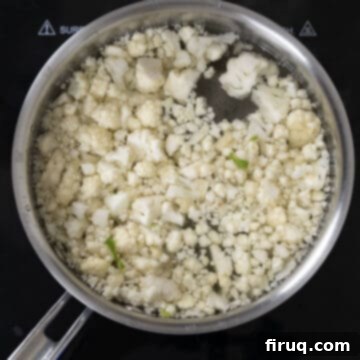
Step 1: Prepare and Boil the Cauliflower. Begin by thoroughly washing and chopping your head of cauliflower into small, uniform florets. This ensures even cooking. Bring a large pot of salted water to a rolling boil. Carefully add the cauliflower florets and boil for approximately 5-7 minutes, or until they are tender enough to be easily pierced with a knife or fork. The goal is for them to be quite soft, as this will help them break down later, creating a creamy texture. Once tender, strain the cauliflower and set it aside, reserving some of the cooking water.
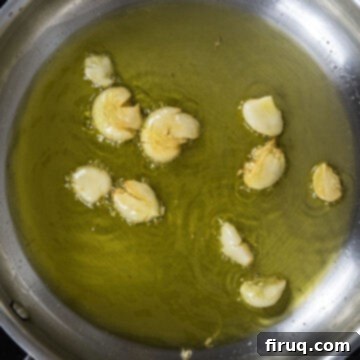
Step 2: Sauté the Garlic and Cook the Pasta. In a large, deep pan or a Dutch oven, heat ¼ cup of good quality olive oil over medium-low heat. Add the crushed garlic cloves. Sauté gently, stirring occasionally, until the garlic turns a light golden brown and becomes incredibly fragrant – typically 2-3 minutes. Be careful not to burn it, as burnt garlic can taste bitter. While the garlic is infusing the oil, bring another pot of heavily salted water to a boil for your spaghetti (or use the same pot as the cauliflower if you prefer, just be sure to re-salt the water generously). Cook the spaghetti according to package directions until it’s al dente.
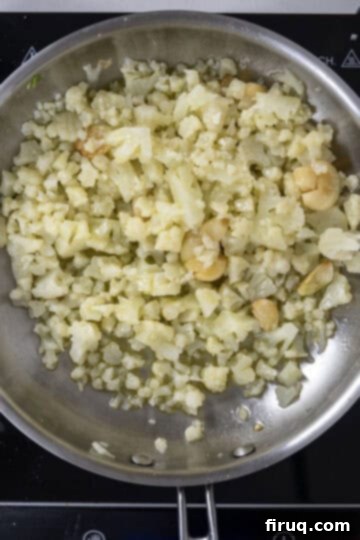
Step 3: Combine Cauliflower and Garlic. Once the garlic is aromatic and lightly browned, add the boiled cauliflower to the pan. Using a wooden spoon or a potato masher, gently crush the cauliflower into small, irregular pieces. This step is key to creating that wonderful, creamy texture that coats the pasta so well. Let the cauliflower simmer in the garlic-infused olive oil for a few minutes, allowing the flavors to meld beautifully. Add about ¼ cup of the reserved pasta water at this stage to help create a saucy consistency and prevent dryness. Season with a pinch of salt to taste.
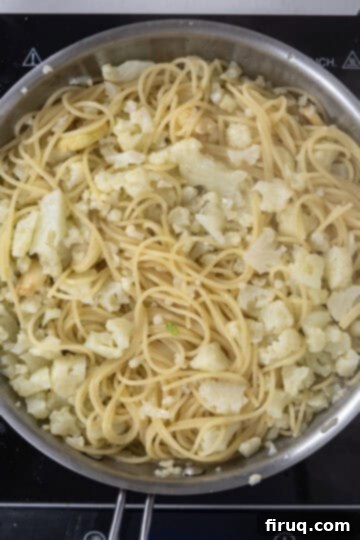
Step 4: Finish and Serve. Using tongs, transfer the al dente spaghetti directly into the pan with the cauliflower and garlic mixture. Add another ½ cup of the reserved pasta water. Stir vigorously, tossing the pasta with the sauce until everything is beautifully combined and the sauce coats the spaghetti evenly. The starchy pasta water will help create a silky, emulsified sauce. Taste and adjust salt as needed. Finally, stir in the fresh chopped parsley and a generous amount of grated Parmesan cheese. Remove from heat immediately. Serve your garlic cauliflower pasta hot, with an additional sprinkling of Parmesan and fresh parsley for garnish. Enjoy this comforting and flavorful weeknight wonder!
Pro-Tips for Perfect Cauliflower Pasta Every Time
Achieving a restaurant-quality cauliflower pasta at home is easier than you think with these expert tips:
- The Unsung Hero: Pasta Water. Never, ever discard all your pasta water! This starchy liquid is your secret weapon for a perfectly emulsified sauce. Always save at least a cup. The starch in the water helps bind the oil and other ingredients, creating a creamy, glossy sauce that clings beautifully to the pasta. While we suggest starting with ¼ cup, don’t hesitate to add a little more if your sauce seems too dry or you prefer a looser consistency. The exact amount can vary depending on your heat level and desired texture.
- Frozen Cauliflower Shortcut. If you’re short on time or fresh cauliflower isn’t available, frozen cauliflower florets are a fantastic alternative. The best part? You can skip the boiling step entirely! Simply add the frozen cauliflower directly to the pan with the sautéed garlic and olive oil. It will thaw and cook down as it simmers, achieving that soft, mashable texture needed for the sauce. This shaves precious minutes off your cooking time without compromising flavor.
- Don’t Rush the Garlic. The garlic is the backbone of this dish’s flavor. Ensure you sauté it over medium-low heat until it’s just lightly golden and aromatic. Burnt garlic will turn bitter and ruin the dish, so keep a watchful eye!
- Embrace the Mash. The more you mash the boiled cauliflower into smaller pieces, the creamier and more integrated your “sauce” will be. Don’t be afraid to really get in there with your wooden spoon or a fork.
- Season as You Go. Salt your pasta water generously – this is your first layer of seasoning. Then, taste the cauliflower mixture before adding the pasta and adjust the salt. A final seasoning check after the Parmesan is added ensures a perfectly balanced flavor.
Serving Suggestions: What to Pair with Your Cauliflower Pasta
This versatile garlic cauliflower pasta is hearty enough to stand on its own as a main course, but it also makes a wonderful side dish or can be elevated with additional protein or vegetables. Here are some ideas to complete your meal:
- Complementary Proteins: Enhance your meal with a delicious protein. Consider serving it alongside crispy and flavorful Italian chicken cutlets, a perfectly seared cast iron chicken breast, or the elegant Restaurant-Style Chicken Saltimbocca for a truly special dinner.
- Seafood Pairings: The light, garlicky notes of this pasta are a fantastic match for seafood. Try it with a delicate Lemon Pistachio Crusted Snapper, the flavorful Fried Flounder Oreganata, or classic Steamed Mussels in White Wine for an elevated experience.
- More Greens & Vegetables: If you’re looking to boost your vegetable intake, this pasta pairs beautifully with a simple green salad or additional cooked greens. Consider a vibrant side of Easy Steamed Artichokes or savory Sautéed Rapini with Garlic for an authentic Italian touch. A simple side of roasted asparagus or a fresh Caprese salad would also be wonderful.
- Crusty Bread: Don’t forget a good loaf of crusty Italian bread to sop up any leftover sauce – it’s a must!
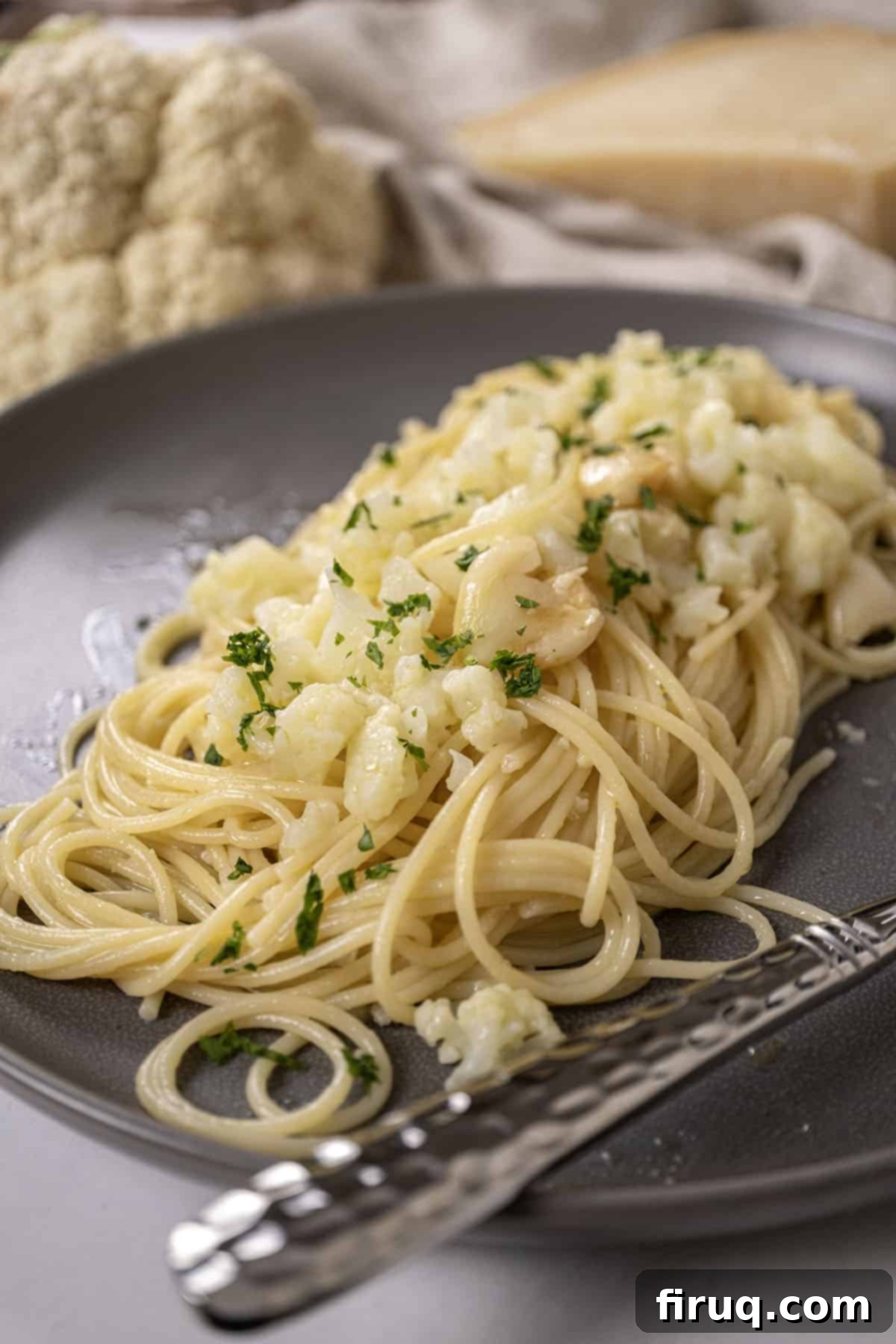
Frequently Asked Questions About Our Cauliflower Pasta
Curious about certain aspects of this recipe? We’ve gathered some common questions to help you master this delicious pasta dish.
For a vegetable-forward pasta like this, a light and fruity Pinot Noir would be an excellent choice. Its subtle notes and balanced acidity complement the earthiness of the cauliflower and the richness of the garlic and olive oil without overpowering the dish. Other good options include a crisp Sauvignon Blanc or a dry Rosé.
Boiling the cauliflower first is a crucial step for two main reasons. Firstly, raw cauliflower takes a considerable amount of time to soften when only sautéed, which would extend our 30-minute cooking goal. Boiling ensures it becomes tender quickly. Secondly, and perhaps more importantly, pre-boiling the cauliflower allows it to be easily mashed into small pieces in the pan. This creates a beautifully creamy and cohesive “sauce” that blends seamlessly with the olive oil and garlic, coating the pasta wonderfully and enhancing the overall texture and flavor.
In this specific recipe, boiling is indeed better than steaming. We want the cauliflower to become quite soft, almost to the point where it can easily fall apart, because our goal is to crush it into small, integrated pieces that create a creamy sauce. Large chunks of cauliflower are not what we’re aiming for here. If you were planning to eat cauliflower on its own as a side dish, steaming would generally be preferred as it helps the florets retain their shape, firm texture, and slightly more of their water-soluble nutrients. But for this pasta, embrace the boil!
Absolutely! This recipe is easily adaptable for a gluten-free diet. Simply substitute regular spaghetti with your favorite gluten-free pasta. The cooking method for the cauliflower and sauce remains exactly the same, ensuring you still get to enjoy all the wonderful flavors.
Yes, feel free to experiment with other fresh herbs! While parsley adds a classic, bright note, a sprinkle of fresh basil or a touch of oregano could also complement the flavors beautifully. Add them at the very end, just before serving, to preserve their fresh taste and aroma.
More Quick and Easy Meal Inspiration from Our Kitchen
If you loved how simple and satisfying this garlic cauliflower pasta was, you’re in for a treat! We specialize in crafting delicious, no-fuss recipes that fit perfectly into a busy lifestyle without ever compromising on flavor. Explore more of our quick and easy favorites designed to make weeknight cooking a joy:
- Pan-Seared Vermillion Snapper
- Classic Linguine Alla Puttanesca
- Italian Pink Sauce with Sausage
- Pasta with Peas and Pancetta
If you’ve enjoyed making this delightful pasta with cauliflower, we’d absolutely love to hear from you! Your feedback helps us grow and continue sharing delicious recipes. Please take a moment to leave a comment and let us know what you think of our recipes; it goes a long way to support our website! For daily dose of scratch-made inspiration and more easy, flavorful meals, make sure to follow us @vindelgiudice on Instagram!
📖 Recipe
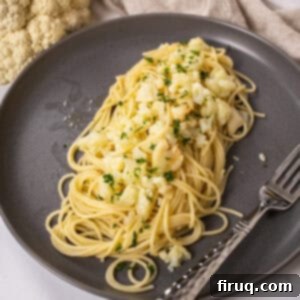
Pasta with Cauliflower
Vincent DelGiudice
Pin Recipe
Equipment
-
1 large saucepan
-
1 large pot
Ingredients
- 1 head cauliflower, chopped
- 1 lb spaghetti
- 1 head garlic cloves crushed
- ¼ cup olive oil
- 1-2 teaspoon salt
- ½ cup parmesan
- fresh chopped parsley
Instructions
-
Chop cauliflower into florets and rinse well. Bring a pot of water to a boil and boil cauliflower until it is soft and easily breakable, about 5-7 minutes.
-
Bring another pot of water to a boil or use the same water to boil your spaghetti, just add salt.
-
While the spaghetti is boiling, bring a large pan to medium-low heat. Add ¼ cup of olive oil. Once it is shimmering add the crushed garlic cloves and stir until slightly browned. Add the cauliflower in and break it up into little pieces with a wooden spoon. Add salt and ¼ cup of pasta water. Strain and add spaghetti once it is al dente.
-
Stir until the cauliflower is well mixed in the spaghetti and then remove from heat and add cheese. Serve with more parmesan and fresh chopped parsley.
Notes
- Pasta water is key. Always save about a cup of pasta water to adjust the texture. I added about a ¼ cup but depending on the heat, you may want to add a little more.
- If you use frozen cauliflower, you can skip the boiling cauliflower step and pour the cauliflower right in with the garlic.
Nutrition
Tried this recipe?We’d love for you to Leave a Review!
